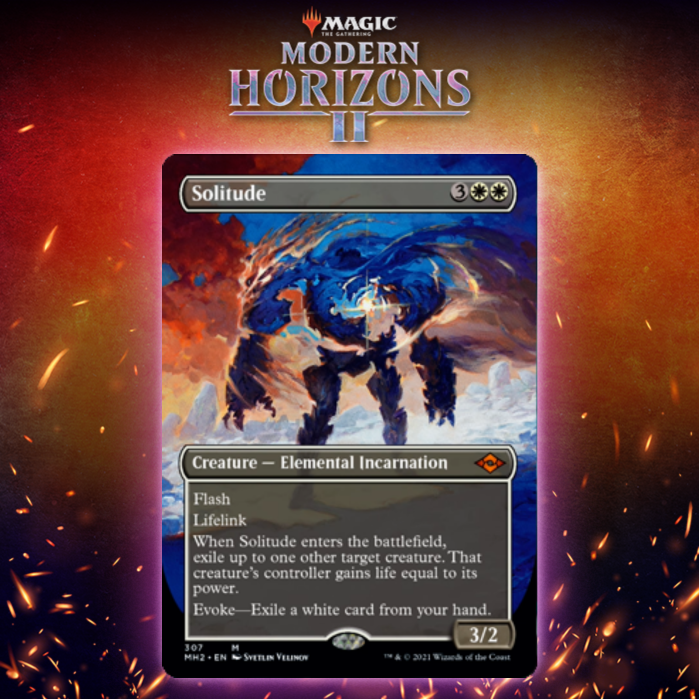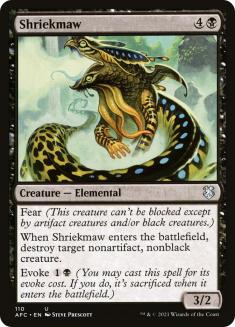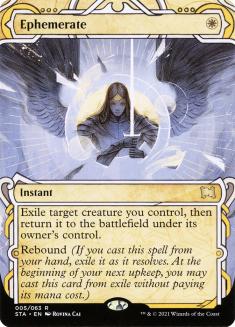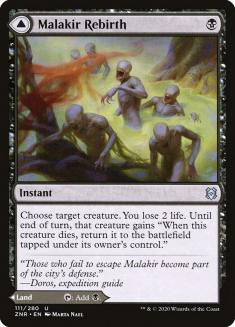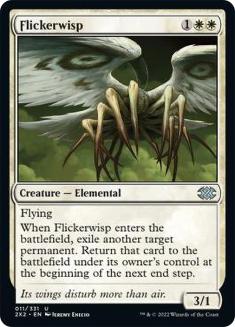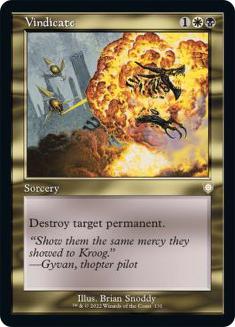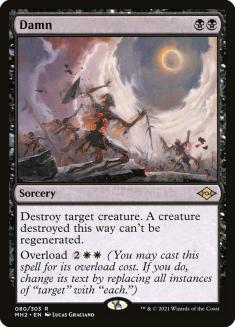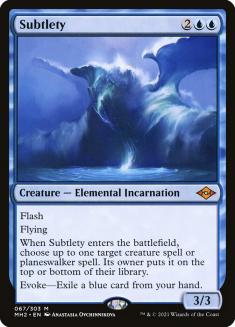There are many powerful cards in Modern Horizons 2, but perhaps the most talked about are the cycle of mythic Elemental Incarnations — creatures with enter-the-battlefield abilities that can evoke by pitching a card of their color. This makes sense; free spells are notoriously powerful and Force of Negation is already one of the strongest cards in the format. In today’s article, I’ll be talking about the white card of the cycle: Solitude.
The easiest historical comparison to Solitude is Shriekmaw.
Shriekmaw was also a 3/2 for five mana, but it loses out to Solitude in a lot of aspects. First, Terror is a much worse effect than Swords to Plowshares, as exiling can be very important and you’re not limited in your targets. Second, lifelink is a better ability than fear for the most part. Third, Solitude has flash, which brings it to a whole new level. Of course, Shriekmaw is currently Modern legal and it doesn’t see much play, so is Solitude enough stronger than Shriekmaw to break through?
I think it is. It’s not busted or bannable, but still strong enough to see play in some of the most powerful formats in Magic, especially those that don’t have access to actual Swords to Plowshares, such as Modern.
At first glance, it might look like you’re not actually saving that much mana with the evoke from Solitude; after all, most of the removal in Modern costs one mana. This is true, but it’s also true that Swords to Plowshares is the best spot removal spell in the history of the game and I don’t think the competition is particularly close. Exiling any creature is huge, and the lifegain is almost always irrelevant (and sometimes a bonus if you’re playing against Death’s Shadow, as a single Solitude will kill any number of Death’s Shadows). For one mana you could save a card and play Path to Exile instead, but then you’re giving the opponent a land, which in some cases might be worse than losing a card yourself.
It’s also important to note the difference between zero mana and one mana is not “just one mana”. Having a spell that’s actually free has the potential to change how a particular game is played because you could cast it at any time. When you have Path to Exile, you might sometimes need to keep mana up to cast it in situations where you end up not actually casting it, which means it costs you more than one mana throughout the game. For example, imagine your opponent has Glistener Elf or a prowess creature and they’re threatening to kill you. In this spot, you might need to keep up Path to Exile mana, because if they go for it you need to have an answer; if they don’t go for it, however, you either waste that mana or Path a suboptimal target. With Solitude, you can continue playing your game and, if they do go for it, you have an answer. Not to mention the times where you have Path to Exile and a three-drop on Turn 3 but you have to spend your turn casting the Path to Exile, which means it effectively cost three mana if you have nothing else to do with the two mana you have left.
At the same time, the mere fact that Solitude exists means your opponent has to play more conservatively sometimes. Can they even go all-in on that Glistener Elf? They might have to play more conservatively. Imagine, for example, you have a planeswalker on the battlefield — let’s say a Jace, the Mind Sculptor with three loyalty and you’re tapped out. Your opponent has two 3/3 creatures. Before Solitude, they would just attack Jace with one of the creatures and you with the other; now, they might feel forced to attack Jace with both, because if you have Solitude you can actually untap with your planeswalker. In this case, Solitude is giving you an advantage merely by existing (while also randomly being a blowout if they don’t play around it).
If that was all Solitude was — a free Swords to Plowshares — it might not be good enough (exiling a card is, after all, a steep cost). However, that’s not all it is. For five mana, you get the option of casting an actually reasonable effect, exiling a creature at instant-speed and producing a 3/2 lifelinker that can get you out of burn range is potentially game changing. On top of that, it looks like a spell but it’s actually a creature! This is relevant for a few things:
- It can stop Emrakul, the Aeons Torn, since it’s not an instant. All in all, Solitude is probably the best single answer to Emrakul in all of Magic, since it deals with it for zero mana. Your opponent cast Through the Breach and put the 15/15 on the battlefield? No problem, you can answer that even if you’re tapped out. If Solitude becomes widely played, it might force any Emrakul-based combo deck to find a different big creature altogether, because going through all these hoops to gain fifteen life is not going to be pleasant.
- It dodges Negate-type effects. Force of Negation and Dovin’s Veto are two commonly played cards in Modern and anyone who has them will bring them in against you, so having your removal spell be immune to those can be relevant.
- It’s tutorable by cards that find creatures, which are more common than cards that find instants. Legacy Death and Taxes, for example, will likely be interested in at least one copy of Solitude, which it can find with Recruiter of the Guard. In Modern, you might want to use Traverse the Ulvenwald.
- It can be reanimated. This is very convenient because these cards can put themselves in the graveyard for free, making them prime reanimation targets for cards that care more about the effect you’re getting than the body, such as the new card Persist. I really like Persist with the Evoke creatures, even if the -1/-1 counter can be quite annoying on a lifelinker.
- It can be blinked. By being a creature with an enters the battlefield ability, Solitude can be more reusable than a spell (though that’s not all upside — it doesn’t work with Snapcaster Mage, for example). Right now, there are a couple of ways to blink it, but the most talked about is Ephemerate.
Ephemerate is really good with the mythic Elemental Incarnations because it’s a cheap instant, which means you can hit your creature before it goes away even if you evoke it. In theory, on Turn 1, you could evoke one of these and, with the trigger on the stack, cast Ephemerate on it, which will bring it back for an extra trigger now and an extra trigger next turn, resulting on three triggers and the creature on the battlefield.
Of course, when we’re talking about Solitude, this play doesn’t really work, because no one is going to have three creatures in play by Turn 1 for you to target (this is more Grief’s thing). Still, in the middle of the game, this can be a potent play; for only one mana, you can immediately exile your opponent’s best two creatures and produce a 3/2 lifelinker, with another exile on the way. More importantly, Ephemerate is a white card so it pitches to cast Solitude!
Malakir Rebirth is not exactly a blink card, but it effectively acts like one when you’re evoking the creature. For one mana, you get to exile their best two creatures and you’re left with a 3/2 lifelinker. In the end it’s a three-for-three, but the tempo you gain is enormous.
The other easy way to bink something is Yorion, Sky Nomad. Unlike Ephemerate, Yorion is sorcery-speed, which means it doesn’t work with the evoke part of Solitude, but if you already have a Solitude on the battlefield, it works pretty well. Perhaps even more important is the fact that Yorion is a guaranteed free card to pitch; if you’re desperate, you can pay three mana to bring back Yorion and use it to Evoke Solitude onto the battlefield.
White players in older formats are no strangers to Flickerwisp, and Solitude is another powerful card to blink with it. If you have Aether Vial with three counters out, you can use it as a pseudo-Ephemerate and blink it with the evoke trigger on the stack as well.
So, where would I play Solitude? The first option is a blink-based Orzhov deck. This deck isn’t exactly new. A version of it Top 8ed a Modern Super Qualifier recently:
Creatures (35)
- 4 Flickerwisp
- 4 Tidehollow Sculler
- 4 Stoneforge Mystic
- 3 Wall of Omens
- 4 Wasteland Strangler
- 4 Giver of Runes
- 4 Charming Prince
- 4 Skyclave Apparition
- 4 Elite Spellbinder
Lands (30)
Spells (15)

This type of deck seems like a prime candidate for Solitude, and it also gains some powerful tools from Modern Horizons 2:
Grief is the obvious new addition, because it works with every card that Solitude works with. The potential issue is the balancing act of having black and white spells to pitch, since you want to support both creatures. If we’re to play both, the deck will have to change a little, perhaps moving away from Aether Vial and playing fewer creatures and more control elements.
Vindicate is a powerful spell. Being able to deal with lands for three mana nowadays is sort of a novelty, and an effect that a deck with Elite Spellbinder might be interested in. More importantly, Vindicate is both a black and a white card, which is at a premium if we want to play both Grief and Solitude.
Damn is, in my opinion, one of the best two sweepers we’ve ever had in Magic if your mana can support it (Terminus being the other one, with the right support). The flexibility of just killing any creature for two mana or clearing the battlefield for four will mean that decks that would never even consider playing a sweeper will have access to it. This Orzhov deck, for example, would never play a sweeper, as it’s mostly creatures, but having Damn means that it can have access to it if it needs to, which will force people to play differently against you as well.
So, how would I build this deck?
Creatures (29)
- 1 Shriekmaw
- 4 Tidehollow Sculler
- 4 Stoneforge Mystic
- 4 Wasteland Strangler
- 4 Skyclave Apparition
- 4 Elite Spellbinder
- 4 Grief
- 4 Solitude
Lands (25)
Spells (26)

This deck relies on modal DFCs and gold cards to support both Grief and Solitude. There are 26 black cards and 33 white cards in it (plus the Yorion, Sky Nomad that you always have access to). It’s important to note that Wasteland Strangler is not black, but even then I think it’s still worth playing, as it combines quite well with the rest of your deck, as it works with Solitude and it also works with all the cards that work with the Evoke creatures. On top of that, if the evoke creatures become popular, you might not need to do a lot of work to trigger it, as your opponent will be exiling cards for you. For example, your opponent might play Grief on Turn 1 only to be met by a Wasteland Strangler that will kill one of their creatures on Turn 3.
The main problem with this deck is that there’s not a lot of card advantage outside of the creatures. If your stuff gets going and you manage to get a lot of two-for-ones from the creatures, that’s going to be good enough but you have no traction to get going to begin with. You might have mismatched draws with no way to fix them, you might draw too many or too few lands, etc. One potential way to solve this problem is by playing blue.
One intriguing card from Modern Horizons 2 that might solve all your card drawing problems is Moderation:
This card works very weirdly with free spells – at a glance, it’s not great, because you can only cast one spell anyway, but given that both the blue and the white mythic Elemental Incarnations have flash, you can end up in scenarios where you cast a spell on your turn and then have a free spell to cast on their turn, and Moderation itself will fuel all the pitch spells you want.
You could, for example, play Moderation on Turn 3, and then immediately cast Solitude on your opponent’s turn – the drawback of having to pitch a card basically disappears once Moderation is on the battlefield. Then, on Turn 4 you can cast Supreme Verdict or Jace, the Mind Sculptor, pass the turn, and then when they play a creature you cast either Solitude or Subtlety (drawing a card for your troubles with each of these spells). You then untap into an empty battlefield with your card advantage engine already on the battlefield and it should be pretty hard to lose from there, even if you can only cast one spell a turn. You have to give up Snapcaster Mage, of course, but I think it’s at least worth trying.
Here’s how a deck playing the pitch spells and Moderation would look like in my mind:
Creatures (8)
Planeswalkers (9)
Lands (31)
Spells (32)

Yorion does not have a lot of value here, but it still works with the planeswalkers and the evoke creatures, and you can simply use it as an extra card to pitch for either of them (as well as Force of Negation), so I think it’s worth having. On top of that, you can potentially blink Moderation to cast another spell in the same turn, such as an evoke spell or Path to Exile.
Teferi, Time Raveler is not usually a four-of in the Modern Azorius decks either, but there are enough synergies that I think it’s worth it. Not only does it pitch to either spell as well but you can use it to return Solitude or Subtlety to your hand if you want a rebuy on the effect. Perhaps more importantly, it works very well with Moderation, since you can use it to bounce the card back to your hand once your hand is stacked, and the ability to cast sorceries at instant speed when you can only cast one spell a turn can be relevant (though we don’t have a ton of sorceries here anyway).
Of course, both these decks are decks that are trying to push Solitude; they’re trying to make the card as best as it can be. I don’t think it requires quite as many synergies to be good. You could simply slot a couple of copies into a regular Azorius deck and I think it would be a good card, without having to warp your deck to support it. Given that the card is just being released, though, I think it pays off to try to maximize it to see just how good a free, potentially recurring Swords to Plowshares can be in the format.

